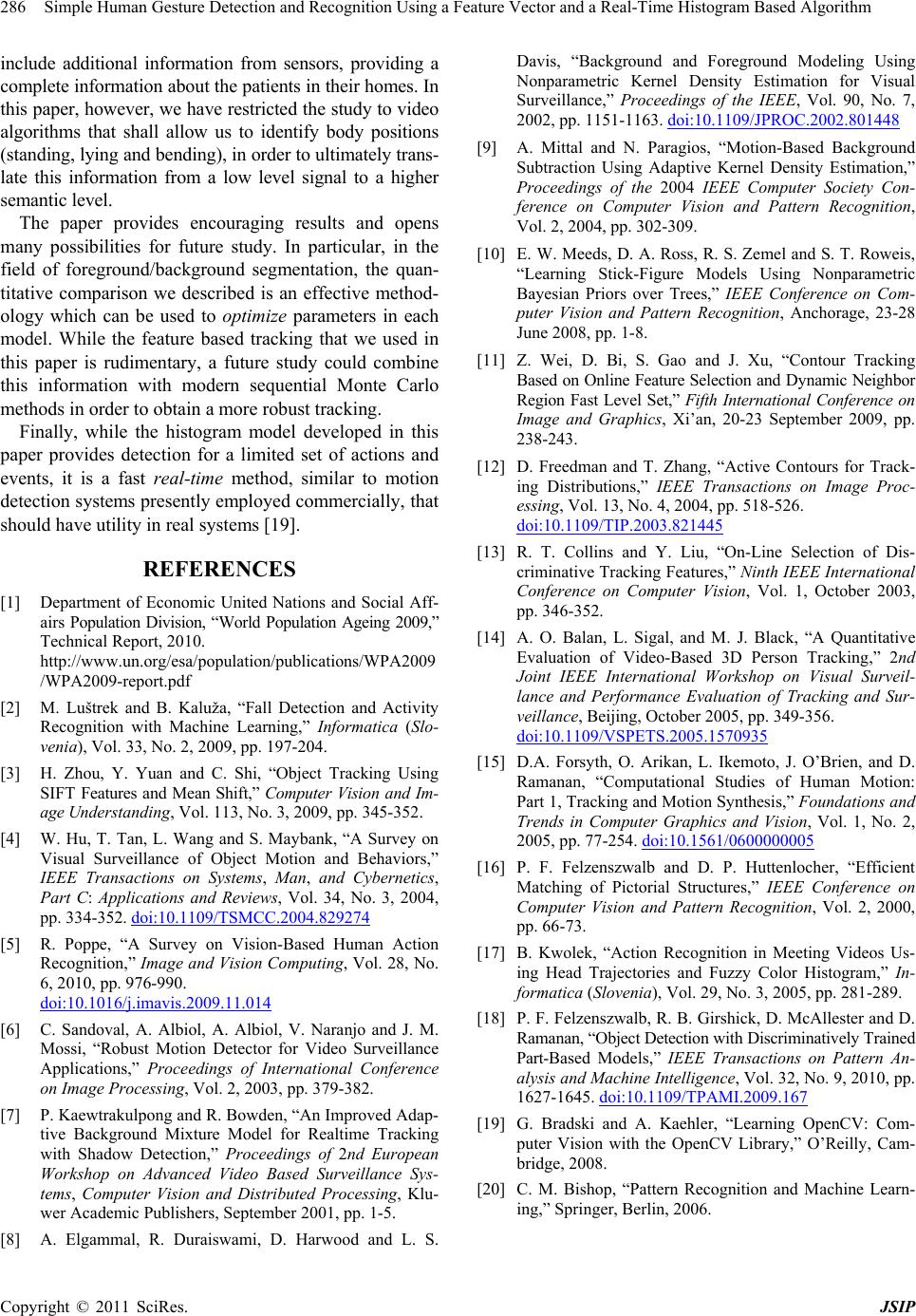
Simple Human Gesture Detection and Recognition Using a Feature Vector and a Real-Time Histogram Based Algorithm
Copyright © 2011 SciRes. JSIP
286
include additional information from sensors, providing a
complete information about the patients in their homes. In
this paper, however, we have restricted the study to video
algorithms that shall allow us to identify body positions
(standing, lying and bending), in order to ultimately trans-
late this information from a low level signal to a higher
semantic level.
The paper provides encouraging results and opens
many possibilities for future study. In particular, in the
field of foreground/background segmentation, the quan-
titative comparison we described is an effective method-
ology which can be used to optimize parameters in each
model. While the feature based tracking that we used in
this paper is rudimentary, a future study could combine
this information with modern sequential Monte Carlo
methods in order to obtain a more robust tracking.
Finally, while the histogram model developed in this
paper provides detection for a limited set of actions and
events, it is a fast real-time method, similar to motion
detection systems presently employed commercially, that
should have utility in real systems [19].
REFERENCES
[1] Department of Economic United Nations and Social Aff-
airs Population Division, “World Population Ageing 2009,”
Technical Report, 2010.
http://www.un.org/esa/population/publications/WPA2009
/WPA2009-report.pdf
[2] M. Luštrek and B. Kaluža, “Fall Detection and Activity
Recognition with Machine Learning,” Informatica (Slo-
venia), Vol. 33, No. 2, 2009, pp. 197-204.
[3] H. Zhou, Y. Yuan and C. Shi, “Object Tracking Using
SIFT Features and Mean Shift,” Computer Vision and Im-
age Understanding, Vol. 113, No. 3, 2009, pp. 345-352.
[4] W. Hu, T. Tan, L. Wang and S. Maybank, “A Survey on
Visual Surveillance of Object Motion and Behaviors,”
IEEE Transactions on Systems, Man, and Cybernetics,
Part C: Applications and Reviews, Vol. 34, No. 3, 2004,
pp. 334-352. doi:10.1109/TSMCC.2004.829274
[5] R. Poppe, “A Survey on Vision-Based Human Action
Recognition,” Image and Vision Computing, Vol. 28, No.
6, 2010, pp. 976-990.
doi:10.1016/j.imavis.2009.11.014
[6] C. Sandoval, A. Albiol, A. Albiol, V. Naranjo and J. M.
Mossi, “Robust Motion Detector for Video Surveillance
Applications,” Proceedings of International Conference
on Image Processing, Vol. 2, 2003, pp. 379-382.
[7] P. Kaewtrakulpong and R. Bowden, “An Improved Adap-
tive Background Mixture Model for Realtime Tracking
with Shadow Detection,” Proceedings of 2nd European
Workshop on Advanced Video Based Surveillance Sys-
tems, Computer Vision and Distributed Processing, Klu-
wer Academic Publishers, September 2001, pp. 1-5.
[8] A. Elgammal, R. Duraiswami, D. Harwood and L. S.
Davis, “Background and Foreground Modeling Using
Nonparametric Kernel Density Estimation for Visual
Surveillance,” Proceedings of the IEEE, Vol. 90, No. 7,
2002, pp. 1151-1163. doi:10.1109/JPROC.2002.801448
[9] A. Mittal and N. Paragios, “Motion-Based Background
Subtraction Using Adaptive Kernel Density Estimation,”
Proceedings of the 2004 IEEE Computer Society Con-
ference on Computer Vision and Pattern Recognition,
Vol. 2, 2004, pp. 302-309.
[10] E. W. Meeds, D. A. Ross, R. S. Zemel and S. T. Roweis,
“Learning Stick-Figure Models Using Nonparametric
Bayesian Priors over Trees,” IEEE Conference on Com-
puter Vision and Pattern Recognition, Anchorage, 23-28
June 2008, pp. 1-8.
[11] Z. Wei, D. Bi, S. Gao and J. Xu, “Contour Tracking
Based on Online Feature Selection and Dynamic Neighbor
Region Fast Level Set,” Fifth International Conference on
Image and Graphics, Xi’an, 20-23 September 2009, pp.
238-243.
[12] D. Freedman and T. Zhang, “Active Contours for Track-
ing Distributions,” IEEE Transactions on Image Proc-
essing, Vol. 13, No. 4, 2004, pp. 518-526.
doi:10.1109/TIP.2003.821445
[13] R. T. Collins and Y. Liu, “On-Line Selection of Dis-
criminative Tracking Features,” Ninth IEEE International
Conference on Computer Vision, Vol. 1, October 2003,
pp. 346-352.
[14] A. O. Balan, L. Sigal, and M. J. Black, “A Quantitative
Evaluation of Video-Based 3D Person Tracking,” 2nd
Joint IEEE International Workshop on Visual Surveil-
lance and Performance Evaluation of Tracking and Sur-
veillance, Beijing, October 2005, pp. 349-356.
doi:10.1109/VSPETS.2005.1570935
[15] D.A. Forsyth, O. Arikan, L. Ikemoto, J. O’Brien, and D.
Ramanan, “Computational Studies of Human Motion:
Part 1, Tracking and Motion Synthesis,” Foundations and
Trends in Computer Graphics and Vision, Vol. 1, No. 2,
2005, pp. 77-254. doi:10.1561/0600000005
[16] P. F. Felzenszwalb and D. P. Huttenlocher, “Efficient
Matching of Pictorial Structures,” IEEE Conference on
Computer Vision and Pattern Recognition, Vol. 2, 2000,
pp. 66-73.
[17] B. Kwolek, “Action Recognition in Meeting Videos Us-
ing Head Trajectories and Fuzzy Color Histogram,” In-
formatica (Slovenia ), Vol. 29, No. 3, 2005, pp. 281-289.
[18] P. F. Felzenszwalb, R. B. Girshick, D. McAllester and D.
Ramanan, “Object Detection with Discriminatively Trained
Part-Based Models,” IEEE Transactions on Pattern An-
alysis and Machine Intelligence, Vol. 32, No. 9, 2010, pp.
1627-1645. doi:10.1109/TPAMI.2009.167
[19] G. Bradski and A. Kaehler, “Learning OpenCV: Com-
puter Vision with the OpenCV Library,” O’Reilly, Cam-
bridge, 2008.
[20] C. M. Bishop, “Pattern Recognition and Machine Learn-
ing,” Springer, Berlin, 2006.